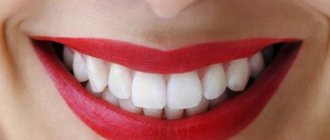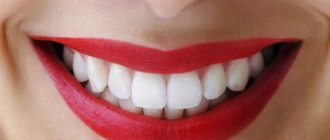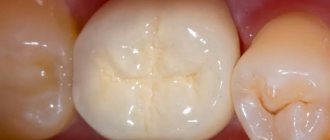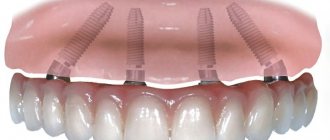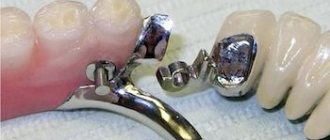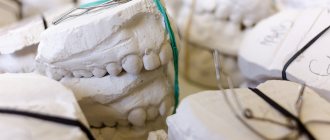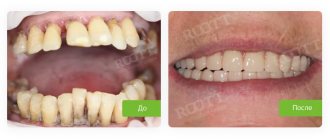- Types of prosthetics
- Materials for prosthetics
- CAD/CAM system
Not every second patient can boast of a smile with all 32 teeth.
The vast majority, some units are missing, or artificial ones are installed instead of living ones. Just like a hundred years ago, today, the most common dental problem is the absence of one or more teeth. Modern medicine offers many technologies for creating new, high-quality and reliable analogues. Prosthetic dentistry helps restore the beauty and functionality of the entire jaw. There are two types of methods for restoring the shape and appearance of a tooth – prosthetics and cosmetic restoration. They are used in different cases, depending on the clinical situation. Science is developing and offering more and more new installation methods and types of orthopedic structures. Nowadays, in almost every clinic you can find modern equipment that can carry out all types of diagnostics. With its help, the doctor can determine the diagnosis with almost one hundred percent accuracy and prescribe the necessary treatment. Before starting any dental procedure, an x-ray examination is required. The image helps to see the condition of the oral cavity in different formats: 3D or 2D.
Before proceeding with prosthetics, you will undergo all the necessary diagnostic measures, draw up an anamnesis and a treatment plan.
The latest dental prosthetics
People have been aware of the need for dental prosthetics since ancient times. The manufacture of dentures was reduced to crafts from seashells, animal bones, precious stones and even wood. But all this dental prosthetics was used only to mask the resulting defect, rather than to restore chewing function. For example, the products of ancient dental jewelers served primarily social purposes, and only then practical ones. The richest people of Ancient Rome could decorate their smiles with gold only to demonstrate their status to others.
In modern dentistry, dentures are an important part of dental treatment. The production of dentures does not stand still and constantly offers new technologies, expanding the possibilities of using various materials. It is difficult to imagine a modern person at business negotiations or at dinner with friends, giving those around him a toothless smile. Therefore, dentistry pays special attention to proper dental prosthetics, which belongs to a separate area - orthopedics. Accordingly, the doctor who performs dental prosthetics is called an orthopedist. In some clinics, dental treatment and prosthetics are performed by one doctor who specializes in orthopedics.
Expected prospects in the field of dental implantation
Modern implants from well-known manufacturers no longer need replacement. The appearance of artificial teeth is practically no different from the appearance of real healthy teeth. However, scientists continue to work to further improve this technology. The ultimate goal in this area of dentistry is to be able to completely imitate the patient's natural dentition.
Spanish scientists have already managed to take the first step in this direction. They created an artificial tooth root, the protective layer of which, during the process of implantation, decomposes and turns into natural bone tissue.
Features of dental prosthetics
Each type of prosthetics has its own characteristics; let’s look briefly at each of them.
Prosthetics of anterior teeth
Requires great attention to the aesthetic side, as well as the shortest possible deadlines. This is due to the fact that few patients can afford to walk for a long time with an obvious aesthetic defect or a “hole” instead of a tooth. Also, prosthetics of the upper front teeth require the use of all-ceramic structures in order to avoid metal showing through the artificial enamel or exposing it in the gingival area.
Prosthetics of chewing teeth
Prosthetics of chewing teeth require more attention to the functional side of the issue. Here, metal-ceramics are acceptable, and in some cases even more preferable, since the strength of structures becomes more important than aesthetics. As for prosthetics on implants, it is advisable to use a two-stage technique, when the implant is first placed, and the crown is installed only after its complete osseointegration.
Prosthetics of the upper jaw teeth
If they are restored after removal, they may require a preliminary sinus lift. This is due to the close location of the maxillary sinuses (sinuses) near the roots of the upper lateral teeth. Sinus lifting is a type of bone grafting that allows you to lift the bottom of the maxillary sinus and fill the vacated space with bone tissue, which will be used to fix the titanium tooth root.
Acry Free - devices that do not chafe
The latest dental prosthetics eliminate the use of hard plastic during the manufacture of removable systems. The dental clinic offers clients designs made from soft and flexible materials. They are elastic and ensure a snug fit of the frame; they fit perfectly in the mouth even without the use of special fixing agents. What is important is that they do not rub or irritate the mucous membranes.
The new generation of removable products is called Acry Free. If we compare them with nylon predecessors, they hold their shape better, do not stretch, do not absorb food odors and do not change their color. Allergic reactions are excluded during their use. The high level of strength of the materials used in the production of Akri Free allows them to chew even hard food without fear of breakage. Getting used to soft systems is much easier. That is why today they are increasingly chosen by people who want to wear removable devices.
Why is it better not to postpone prosthetics?
Where there is no tooth, the chewing load is reduced, which leads to bone atrophy - a progressive process in which the alveolar ridge, where the teeth are located, as well as the jaw as a whole, decreases. With atrophy, the lower third of the face decreases, physiological, functional and aesthetic disturbances occur. Implant prosthetics stops bone atrophy.
The load of the lost tooth falls on the rest, which leads to rapid erosion of the enamel and an increased risk of caries. Over time, you can get several severely damaged teeth in the vicinity of the defect.
If a tooth is missing, its neighbors begin to shift towards the empty space, forming bite defects that disrupt the aesthetics of a smile and interfere with chewing food well. This can lead to problems with the gastrointestinal tract.
The beauty of the smile, the elasticity of the skin and the symmetry of the face suffer, since its soft tissues rest on the teeth, and if a tooth is lost, diction may deteriorate.
New developments by Malaysian scientists
In Malaysia, scientists have also developed their own special implant, which is intended for older people. The essence of their invention is fundamentally reminiscent of the development of their Japanese colleagues. Malaysians also coat the titanium rod and implant abutment, but with a completely different layer. This protective layer consists of ceramics and magnesium silicate. This layer is also very quickly implanted into the bone tissue.
In addition, Malaysian scientists have come up with a new method for making titanium implants. Its essence consists in microwave sintering of the implant after it is coated with titanium powder.
A leading specialist in the development of new dental technologies in Malaysia is scientist Alirez Yaghoubi. He heads an entire scientific group of highly qualified specialists. This group is developing personalized dental systems. In their opinion, this approach is the most promising.
Types of dental prosthetics
What types of prosthetics are there and how do they differ from each other? Dentistry divides dentures into three categories: fixed, partially removable and removable prosthetics. Fixed dentures are:
Turn on adki
Essentially, these are the same fillings, but made in the laboratory using individual impressions, usually made of ceramics. They belong to non-removable dentures. They have maximum precision of fit and high aesthetics. Unlike a conventional filling, a ceramic inlay is more durable and completely invisible on the teeth.
Ceramic veneers
Fixed dentures in the form of thin ceramic plates covering the outer surface of the teeth. As a rule, this type of permanent dental prosthetics is used in the smile area to correct the shape and color of teeth.
Lumineers
Ultra-thin ceramic plates, with the help of which dental prosthetics do not require preliminary serious treatment of the teeth. Unlike veneers, lumineers can be removed, but the list of problems they can treat is very limited.
Dental crown
A cap that replaces the crown of a tooth and imitates its natural shape. The most common option for this type of denture.
Bridge prosthesis
A design of several artificial dental crowns attached to natural teeth or roots. A classic version of dental prosthetics. This category also includes an adhesive bridge, used as a temporary aesthetic structure.
Dental implant
A titanium “root” is implanted into the bone in place of a missing tooth, on which an artificial crown is installed.
All other designs are partially removable or completely removable dentures. These include:
Plate dentures
A prosthesis made of an acrylic or nylon base with artificial teeth placed on it. Can be completely removable and rest on the mucous membrane of the edentulous areas, jaws and palate. And also – partially removable with fixing elements on natural teeth. A complete removable plate denture supported by implants is the most popular and reliable type of implantation today in the absence of teeth.
Clasp dentures
Prostheses with a metal frame, which include devices that hold and unload the structure, arches and artificial teeth. The production of dentures of this type takes place in the laboratory.
Each type of prosthesis and method of dental prosthetics solves a specific functional and aesthetic problem, starting with the ugly color of teeth and ending with their complete absence.
Fixed dentures with immediate loading on implants
Speaking about dentures and their types, we cannot ignore this innovation, which, again, is no longer such for the whole world. And only in Russia it became known relatively recently.
What are fixed prostheses with immediate loading on implants? These are fully functional and extremely easy-to-use structures that are installed 2-3 days after implantation. They are equipped with a thin gingival edge so that the patient does not need to restore gums that have “lost” their beautiful appearance after inflammatory processes and as a result of prolonged absence of teeth.
When implanted with immediate loading, the prosthesis is installed within 3 days
Fixed dentures on implants are securely fixed in the mouth; there is no need and you cannot remove them yourself. They allow you to chew any food and feel its taste, do not interfere with diction, do not cause the sensation of a “foreign” object in the mouth, and even rejuvenate, as many patients note.
Naturally, this is only possible with certain protocols, namely with one-stage implantation. There are different approaches within this method. For example, all-on-4, all-on-6, implantation using basal and zygomatic implants. As well as different options for dental prosthetics: you can install temporary devices made of metal-plastic or permanent ones made of ceramic composite; immediately fixed and removable adaptation solutions are possible to save the budget.
All this is a solution for people with multiple or complete absence of teeth, as well as for patients with periodontal inflammation, chronic diseases and bad habits (smoking), and the elderly. It’s just that an individual solution is selected in each specific case.
Notice
: Undefined variable: post_id in
/home/c/ch75405/public_html/wp-content/themes/UltraSmile/single-item.php
on line
45 Notice
: Undefined variable: full in
/home/c/ch75405/public_html/wp-content /themes/UltraSmile/single-item.php
on line
46
Rate this article:
( 3 ratings, average: 5.00 out of 5)
prosthetics
- Budny A.A., Plodistaya I.D. Modern technologies in orthopedic dentistry // Bulletin of medical Internet conferences. – 2022.
Expert “All modern types of prosthetics are aimed at one way or another to make the patient’s life more comfortable, improve appearance, get rid of complexes, and allow him to chew food. However, to create structures that solve health problems, doctors need to use the latest technologies. For example, digital diagnostic methods and smile design programs. All this helps to comprehensively study the clinical situation, accurately work out important details at the planning stage and create truly comfortable prostheses.” Orthopedic dentist Sambuev Bair Sergeevich
Consulting specialist
Sambuev Bair Sergeevich
Specialization: Orthopedic dentist Experience: 11 years
Materials for dentures
Materials used in orthopedics have special requirements. They must be biologically compatible with human oral tissues and be resistant to saliva and food. Materials should not cause allergies, change taste, or have an odor. Their strength, resilience, elasticity and abrasion should be close to the tissues being replaced. In addition, an important requirement is the possible production of dentures from these construction materials, which are as close as possible in color and appearance to natural teeth and gums. Let's take a closer look at each of them.
Metal
The first metal used to make dentures was gold. Gold teeth had an absolute monopoly for 2,500 years. And even today you can still find owners of metal dentures made of gold. But today, modern dental prosthetics most often uses various metal alloys, usually as auxiliary materials. For example, when making crowns, a metal frame is first cast and then covered with a layer of ceramic. Thus, metal-ceramic dentures are created - the most popular in dentistry today.
Ceramics
The main advantage of ceramic dentures is that they are fully compatible with soft tissue, hypoallergenic and help create natural gum contours. In addition, ceramic structures can be painted in one of the shades that most accurately conveys the natural color of teeth.
Plastic
This type of material is used to create artificial teeth and bases for removable dentures. Dental laboratories use acrylic resin-based plastics to create acrylic dentures. And with the beginning of the use of non-acrylic polymers in dentistry, polyurethane and nylon dentures appeared.
Stock
-27%
Teeth in 1 day on Straumann implants using ProArch technology!
300,000 rub. 220,000 rub.
get -20 %
Manufacturing of removable denture Acry Free 40,000 rub.
32,000 rub.
get -13 %
Metal-free dental crown made of zirconium dioxide 40,000 rub.
35,000 rub.
get -20 %
Manufacturing of removable denture Acry Free 40,000 rub.
32,000 rub. get
Technology and methods of dental prosthetics
The technology of dental prosthetics does not stand still, it is constantly evolving, outdated ineffective methods are becoming a thing of the past, more and more advanced techniques and the most modern materials are appearing. Modern technologies and methods of dental prosthetics involve the widespread use of computers at all stages from diagnostics (taking 3D X-rays) to the manufacture and installation of structures. New technologies in dental prosthetics are, for example, a CAD/CAM system that allows the production of high-precision orthopedic structures using 3D computer models by sawing on a milling machine from high-strength ceramics, while just a few years ago crowns and other prosthetics were made by casting ceramics on metal frames. Thanks to the latest technologies and methods in dental prosthetics, today it is possible to make prosthetics in one visit to the doctor, when the design is made not by a technician in a laboratory, but by a special ultra-modern and high-speed machine, on which the doctor himself models the prosthesis.
Elimination of caries
Modern methods of caries treatment are based on non-invasive therapy, even in the most advanced cases. Often, a drill or traumatic surgical intervention is not required to remove a carious cavity.
The use of a laser is considered a revolutionary technique. The device copes well with removing damaged tooth tissue. And at the same time disinfects the treated area. For surgical operations, the laser is also indispensable, because makes neat, local cuts. This reduces the traumatic nature of the procedure and, as a consequence, the rehabilitation period.
For the treatment of caries in the initial stages, the ozone therapy procedure is effective. Ozone treatment helps get rid of any infection in the oral cavity and prevents the further spread of bacteria. Ozone is used for superficial and fissure caries. And also when the enamel darkens, when bacteria have not yet reached the dentin. The procedure is safe, painless, and is often used in pediatric dentistry.
Air blasting is also used to remove dead tooth tissue. A directed stream of fine particles helps clean the affected tooth cavity, without the use of a drill.
Preparing teeth for prosthetics
Before the manufacture and installation of dentures, careful preparation for dental prosthetics must be carried out. First, any current oral problems such as tooth decay or gum disease such as periodontitis must be addressed. If some chronic diseases cannot be completely cured, it is necessary to put them into remission. Also, prosthetics may require preliminary orthodontic treatment, for example, if there is a severe malocclusion or there is not enough space to install an implant. Before aesthetic microprosthetics with veneers or lumineers, it is necessary to do whitening, and a procedure such as professional teeth cleaning will be required in any case. In addition to the above measures, an orthopedic consultation includes such preliminary steps as consulting a doctor, taking x-rays, drawing up a treatment plan and choosing the optimal type of prosthetics.
Comfortable service
Communication with the doctor reaches a whole new level. You will not be frightened by creepy, incomprehensible terms and dangerous operations. The doctor will be able to show the planned stages of treatment of your teeth on the computer screen in the form of an interactive video and discuss all the points with you. Visits to the dentist will be comfortable and calm.
As you can see, the latest trends in medicine make it possible to simply and quickly solve the most unpleasant and seemingly complex problems. Taking care of your oral health and the beauty of your smile is very easy; all you need to do is consult a doctor on time and be attentive to your feelings.
Timing of dental prosthetics
The next pressing question that worries every patient is “How long does dental prosthetics take?” There are two main calculation criteria here: whether the participation of a dental technician is required in the manufacture of dentures and whether a break is necessary between the main stages of the procedure. Almost all types of orthopedic treatment discussed in this article involve the production of dentures in a dental laboratory using individual casts of the patient. This means that installation of the prosthesis will require two visits to the dentist, with a break necessary for the construction to be made in the laboratory. However, today an increasing number of clinics are acquiring the latest models of milling machines with the ability to instantly produce orthopedic structures using 3D computer models of casts. Thus, the time required for dental prosthetics is reduced to one visit to the dentist. As for dental prosthetics on implants, here you will have to prepare for a longer treatment, since several months (from four to six) necessary for the engraftment of the titanium root may pass between the implantation of the implant and the installation of a permanent crown on it.
Latest achievements in Israeli dentistry
Nowadays, Israeli dentists implant artificial roots using their own technology. Its main difference is the long duration of the operation. It usually lasts from 4 to 8 hours.
Painkillers are introduced gradually and using Sleeper One technology. This ensures maximum comfort for the patient. The first effect of anesthesia begins only 40 minutes after the start of the injection. At the same time, by the beginning of the operation itself, the nerve endings in the jawbone area are completely blocked.
Implantation of artificial roots in Israel is done only in inpatient departments of dental clinics. The time for postoperative rehabilitation there lasts at least three days. During this time, the patient should be absolutely at rest and strictly follow the doctor’s recommendations. Postoperative drug treatment is carried out strictly individually and taking into account the characteristics of the patient’s body. In most cases, dentists prescribe anti-inflammatory and antibacterial agents.
Stages of prosthetics
After all the preparatory procedures, the specialist proceeds directly to prosthetics, which also includes several stages.
- Preparing for installation. When prosthetics supported by implants, in some cases, preliminary bone augmentation is required. To fix a crown or dental bridge, it is necessary to depulpate, that is, remove the nerve, then fill the root and grind the surface. Before installing veneers and inlays, the doctor grinds down about 0.2 - 0.5 millimeters of dental tissue, while lumineers only need light grinding of the tooth shell.
- Making a prosthesis. Impressions of the jaw, X-rays and other necessary patient data are sent to the dental laboratory, based on which a design is created.
- Installation. The finished permanent prosthesis is adjusted to the desired size during fitting. The dentist adds highlights and shadows, adjusts the color and texture to optimally resemble the patient’s natural teeth.
Previously, depulpation was a mandatory point in the process of prosthetics, but in modern clinics doctors have different opinions about the advisability of the procedure. Removing the nerve relieves pain in the tooth area and increases its stability, but shortens the life of the tooth and accelerates tissue destruction. The specialist makes the decision on depulpation based on the diagnosis and the patient’s own feelings.
Installation of crowns
Crowns are used in cases where the tooth has suffered severe decay or discoloration. This method will significantly increase resistance to chewing loads, increase the strength of the tooth and restore its shape, size, and natural color. Depulpation (removal of nerves) is not a mandatory process. Elimination of pulp has an ambiguous effect on the life of the tooth: the access of beneficial substances to the enamel stops, and the base becomes fragile. But it is worth considering that in some cases this is a necessity.
High-quality dental prosthetics
Unfortunately, the installation of dentures does not always go smoothly; sometimes incorrect dental prosthetics causes complications, and quite dangerous ones. However, it is necessary to clearly distinguish between discomfort, which invariably occurs after any serious dental intervention and is considered normal, and actual complications. If after the procedure for one, two or three days (depending on the type of prosthetics) there is slight bleeding in the area of the soft tissue incision, slight swelling or pain suppressed by painkillers, there is no need to sound the alarm, unless the pain is sharp and the bleeding not plentiful. If, within a few days after prosthetics, the tooth hurts very much, the bleeding does not stop, and the swelling does not subside, this means that the doctor made mistakes during dental prosthetics.
ROOTT implant system
The Rutt system includes more than a hundred different implants. This allows materials from a single manufacturer to carry out any type of artificial root implantation. Rutt System implants can be fixed into the jawbone using dental cement, multi-unit or ball-shaped attachments.
The basal implants of the ROOTT system are structurally a single piece with an adapted abutment. The surface of these implants is perfectly smooth, which virtually eliminates the deposition of bacteria. Moreover, such implants are implanted very quickly due to deep threads. Finally, such artificial roots can be installed immediately after the removal of a damaged tooth. Advantages of Rutt system implants:
- minimum cases of rejection;
- ease of installation;
- no contraindications for patients with HIV, AIDS, hepatitis and diabetes;
- installation is allowed for heavy smokers
- the ability to implant roots in case of periodontal diseases.
Dental prosthetics under anesthesia
Implant-supported prosthetics involve major surgery, so the operation is always performed under anesthesia. Patients often choose the most comfortable type of pain relief - sedation or general anesthesia. Local anesthesia is also effective, but some patients find it psychologically difficult to perceive unpleasant sounds and smells during the procedure.
Correct and high-quality installation of a crown or bridge should not cause severe pain. In this case, local anesthesia is used to alleviate discomfort during depulpation, grinding of the tooth and fixation of the structure.
When performing prosthetics with inlays and veneers, an injection of local anesthesia is used, since grinding down the dental tissue causes pain.
Stump tab
If the root of the tooth is preserved and is in good condition, then its crown part can be restored regardless of the degree of its destruction and even in its complete absence. At the same time, adjacent teeth are protected from grinding, although significant medical intervention is still required to open the canals and remove the nerves.
A stump inlay is placed in place of the damaged tooth. Most often it is a monolithic structure, but if it is necessary to restore a tooth with several roots, a collapsible model is used. The inlay has a pin installed in the canal and a stump on which a crown is hung or a bridge is installed. The support of the structure falls on the upper part of the root.
The possibility of such prosthetics is determined after examination of the root and tissues. If cysts and periodontitis are detected, surgical intervention is required. If the root is healthy, it is filled. An inlay made of metal or ceramic is tried on and fixed at a depth of 2/3 of the canal using a special filling material. It is covered with a crown or bridge.
Inlay on the front tooth
The advantages of the method are uniform load on the root, eliminating the possibility of tooth breakage and caries at the border of the inlay, ease and safety of replacement. Disadvantages include high price, manufacturing time and the need to remove living tissue to ensure a tight fit.
Pain after prosthetics
Pain after dental prosthetics can mean prosthetic stomatitis, an inflammatory disease of the soft tissues at the point of contact of the crown and gums. This may occur due to the fact that the crown is put on too “tightly”, as a result of which it puts pressure on the gum, irritating it and injuring it. Pain may occur some time after the installation of a bridge, and one or both supporting teeth begin to hurt. This may mean that caries has gotten under the dentures and affected the supporting teeth. The reason for this is the loose fit of the crowns to the teeth, too large a gap between the bridge and the gum in the place where the tooth is missing, or the ingress of saliva during prosthetics.
Also, do not forget about such an insidious phenomenon as an allergy to the materials from which prostheses are made. If you suffer from at least one type of allergy, before getting prosthetics, you should check your body for compatibility with prosthetic materials.
Photos before and after prosthetics
"Quadrotti" instead of traditional clasp devices
Modern dentistry offers dentures made of hypoallergenic materials that are not inferior in strength to metal, but much more beautiful. What types are there? For example, Quattro Ti, created from Italian-made Dental D material. Many doctors call them modern analogues of metal clasp systems, which are installed subject to the presence in the mouth of at least part of the surviving elements of the row that can serve as support.
There is no palatal overlap in these designs
“Quadrotti” devices are compact, distribute the chewing load well, are comfortable during use, do not cause any special difficulties during the period of adaptation, and do not deform. Like conventional clasp structures, they can be used for periodontitis and periodontal disease (only at the initial and middle stages) to stabilize the dentition and preserve moving elements. The material from which they are made combines optimal flexibility and rigidity.
Cost of dental prosthetics
Prices for dental prosthetics vary widely and depend on many factors. The first is, of course, the material. The more expensive it is, the higher the cost of dental prosthetics will be. The highest prices for dental prosthetics are ceramic veneers, which are classified as permanent dentures. The lowest cost is for removable dentures made of plastic, in particular acrylic. The cost of nylon dentures will be higher. The second factor is the amount of work. It is one thing if it is necessary to compensate for the loss of one tooth, and quite another if all are missing. For example, the price of clasp prosthetics in Moscow also depends on the qualifications of the orthopedist and dental technician, the use of modern technologies and equipment when creating an orthopedic design.
Prices for aesthetic dentistry services
Consultation with a dentist - orthopedist Free Stump tab from RUB 3,900. up to 9500 rub. Ceramic inlay from 8200 rub. up to 17,500 rubles. Metal-ceramic crown CoCr from 7,200 rubles. up to 10,000 rubles. Metal-free ceramics 25,000 rubles. Ceramic veneers from 17,000 rubles. up to 30,000 rubles. Removable prosthesis 9,500 rubles. up to 18,000 rubles Clasp clasp prosthesis from 25,000 rubles up to 28,000 rubles Clasp monomer-free prosthesis 36,000 rubles Nylon prosthesis 15,000 rubles up to 34,000 rubles. Metal ceramics for implants from 20,000 rubles. up to 25,000 rub.What types of dental prosthetics are best?
Every person who decides to undergo prosthetics, of course, is concerned with the pressing question: “What type of dental prosthetics is better?” Here you must first make a reservation about what kind of prosthetics we are talking about: the restoration of destroyed or damaged teeth or the replacement of a completely missing tooth (or several teeth). In the second case - when you need to restore a lost or extracted tooth - to the question “Which dental prosthetics should I choose?” There is only one answer: of course, implantation. However, here too you need to remember that there are pitfalls - for example, contraindications. As for the high price of dental implantation in Moscow, which scares off many patients and forces them to settle for less effective types of prosthetics, it is worth comparing the costs more carefully. The fact is that implants, if all installation rules are followed and with proper care, serve a person for a lifetime, and the crowns on them need to be changed no more often than once every ten, and sometimes fifteen years. As for, for example, bridges, the most popular alternative to implantation, they require replacement on average every five to seven years. In addition, the supporting teeth during bridge prosthetics tend to become loose, which also leads to their loss or destruction. In this state of affairs, the cost of implantation in the long term does not exceed the cost of bridge prosthetics.
However, in the case of prosthetics for partially, completely destroyed or lost teeth, your attending physician will tell you in detail how to choose the optimal treatment method for your specific situation. Remember that no conscientious doctor will remove a tooth and install an implant in its place if this tooth can be at least partially saved and restored using other types of prosthetics. Although an implant is the highest quality type of prosthetics, a native tooth, even if only the root remains, is still better.
Comments
I'm considering partial dentures for myself, but I don't like that they have hooks. To what extent will these hooks actually ruin the appearance of your smile?
Anna (05/02/2021 at 01:46) Reply to comment
- Dear Anna, it all depends on what type of product you are going to choose. If these are clasp dentures, then the hooks in them are usually metal and, yes, if they are located in the smile area, they will be visible when the mouth opens. If these are modern prostheses “Quadrotti” or “Acry-free”, then the hooks can be made of the same material as the base of the prostheses themselves. This material is more aesthetically pleasing than metal; the color of the hooks will almost merge with the shade of natural mucous membrane. But also in order to improve aesthetics and increase the level of comfort, modern patients can choose dentures with clasps or telescopic crowns. This is a more expensive option, but the structures will stay securely in your mouth, and no one will guess that you are wearing artificial teeth.
Reply from the author of the article (05/05/2021 at 09:27) Reply to comment
Good afternoon. I wanted to take care of my teeth and didn’t even know before that there were so many different ways. Are you interested in veneering, does it damage your teeth and how long does it last? That is, is there a risk that in a couple of years it will start to fall off, and its teeth will already be damaged?
Anna (07/08/2021 at 08:30) Reply to comment
There are many methods, but there are many good specialists to find and everyone’s cases are different. What would you recommend that you install it once and for sure, at least gnaw the nuts, so that they don’t break and no longer need repairs.
Olga (07/08/2021 at 09:54) Reply to comment
Hello, I really want a perfect smile and am thinking about getting veneers. Is it safe for young people (I'm 30)? Could there be problems with teeth in the future because of them?
Dasha (07/08/2021 at 12:02) Reply to comment
How long will this type of prosthetics last instead of the 8th and 9th teeth?
Zhanna (07/08/2021 at 14:14) Reply to comment
I have a question. Since childhood, I have had not very good teeth, weak gums and yellowish enamel. Will there be any problems if I decide to get lumineering?
Anton (07/08/2021 at 14:59) Reply to comment
Good afternoon. I was faced with the need to install a crown on the top six. Since this tooth bears quite a large load, I would like the material to be as strong as possible. Is a zirconia prosthesis suitable for this purpose?
Lily (08/04/2021 at 18:23) Reply to comment
Can veneers be installed if there is crooked teeth? My front teeth overlap each other, and I wouldn’t want to straighten them with braces, it’s a very long procedure.
Irina (08/05/2021 at 15:05) Reply to comment
